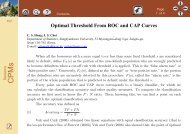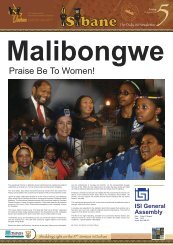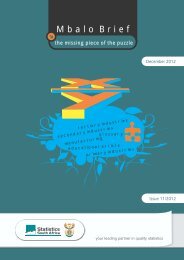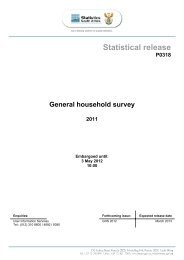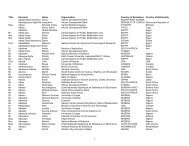Post-enumeration Survey (PES) - Statistics South Africa
Post-enumeration Survey (PES) - Statistics South Africa
Post-enumeration Survey (PES) - Statistics South Africa
You also want an ePaper? Increase the reach of your titles
YUMPU automatically turns print PDFs into web optimized ePapers that Google loves.
<strong>Statistics</strong> <strong>South</strong> <strong>Africa</strong><br />
35<br />
Adjusted census population =<br />
Adjusted 'Population within in-scope sub-universe'<br />
+ Unadjusted 'Balance of population'.<br />
It is worth noting that <strong>PES</strong> adjustment factors were based on the original geographic and demographic<br />
classifications of persons. For geography type and EA type, 'original' referred to the classification in the<br />
Census 2011 frame, before EA type changes occurred. For living-quarters type and for demographic<br />
variables, 'original' refers to these variables as originally reported in the census.<br />
Therefore, to maintain compatibility between the distribution of <strong>PES</strong> cases and census cases, the<br />
original classifications (i.e., unedited or 'raw' data before editing and imputation) were used to decide<br />
which factor a person would receive. Thus, census persons received the adjustment factor<br />
corresponding to their original geography type and EA type, original living-quarters type, and original<br />
sex/age group/population group cell. Once the adjustment factors were applied, persons and households<br />
were permitted to shift to post-editing classification cells (which render census data more accurate and<br />
more meaningful), but they carried their original adjustment factors individually into their new cells.<br />
5.6 Content evaluation for persons<br />
Content analysis is discussed in Section 8.1. The following must be noted regarding the use of the <strong>PES</strong><br />
for the measurement of content error:<br />
• It is limited to matched cases.<br />
• It is limited to the in-scope sub-universe, consisting of dwelling units and hostels within in-scope EA<br />
types.<br />
• The <strong>PES</strong> is not assumed to provide the 'truth'; therefore, response bias is not measured, only<br />
response variance.<br />
• Comparison is of unedited <strong>PES</strong> and census socio-demographic responses. (<strong>PES</strong> socio-demographic<br />
data are not subject to edit; census data are, but these edits take place outside the <strong>PES</strong>.)<br />
• Unlike the census and <strong>PES</strong> questionnaires in the <strong>PES</strong> sample, data capture for the full census was<br />
not by key-from-paper but by scanning with rigorous quality control. In addition, census data were<br />
later subject to an intensive edit and automatic-correction process. Hence, to a certain extent, the<br />
data quality in the published census results is improved over what is indicated by the content analysis.<br />
It was also noted in Section 8.1 that the estimated person totals shown in the content analysis tables do<br />
not coincide with the final census totals for each characteristic because:<br />
• they are based on the sample of census records in the <strong>PES</strong> and are, therefore, subject to sampling<br />
variability;<br />
• they include only matched cases, not the full sample;<br />
• they are unedited while the census characteristics are edited;<br />
• they include only the in-scope sub-universe while the final census totals include the full universe; and<br />
<strong>Post</strong> Enumeration <strong>Survey</strong> (<strong>PES</strong>)



